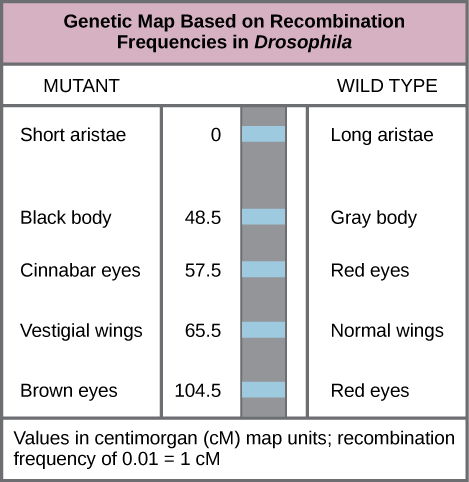| << Chapter < Page | Chapter >> Page > |
Janssen did not have the technology to demonstrate crossing over so it remained an abstract idea that was not widely accepted. Scientists thought chiasmata were a variation on synapsis and could not understand how chromosomes could break and rejoin. Yet, the data were clear that linkage did not always occur. Ultimately, it took a young undergraduate student and an “all-nighter” to mathematically elucidate the problem of linkage and recombination.
In 1913, Alfred Sturtevant, a student in Morgan’s laboratory, gathered results from researchers in the laboratory, and took them home one night to mull them over. By the next morning, he had created the first “chromosome map,” a linear representation of gene order and relative distance on a chromosome ( [link] ).

Which of the following statements is true?
As shown in [link] , by using recombination frequency to predict genetic distance, the relative order of genes on chromosome 2 could be inferred. The values shown represent map distances in centimorgans (cM), which correspond to recombination frequencies (in percent). Therefore, the genes for body color and wing size were 65.5 − 48.5 = 17 cM apart, indicating that the maternal and paternal alleles for these genes recombine in 17 percent of offspring, on average.
To construct a chromosome map, Sturtevant assumed that genes were ordered serially on threadlike chromosomes. He also assumed that the incidence of recombination between two homologous chromosomes could occur with equal likelihood anywhere along the length of the chromosome. Operating under these assumptions, Sturtevant postulated that alleles that were far apart on a chromosome were more likely to dissociate during meiosis simply because there was a larger region over which recombination could occur. Conversely, alleles that were close to each other on the chromosome were likely to be inherited together. The average number of crossovers between two alleles—that is, their recombination frequency —correlated with their genetic distance from each other, relative to the locations of other genes on that chromosome. Considering the example cross between AaBb and aabb above, the frequency of recombination could be calculated as 50/1000 = 0.05. That is, the likelihood of a crossover between genes A/a and B/b was 0.05, or 5 percent. Such a result would indicate that the genes were definitively linked, but that they were far enough apart for crossovers to occasionally occur. Sturtevant divided his genetic map into map units, or centimorgans (cM) , in which a recombination frequency of 0.01 corresponds to 1 cM.

Notification Switch
Would you like to follow the 'Biology' conversation and receive update notifications?